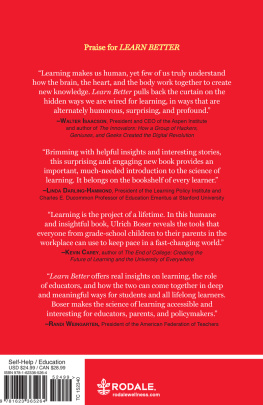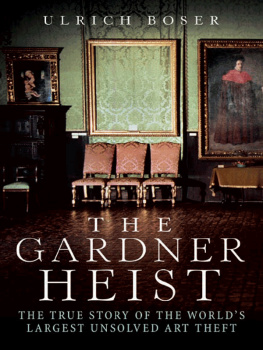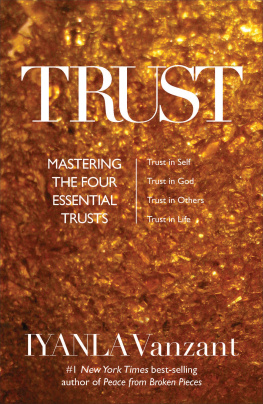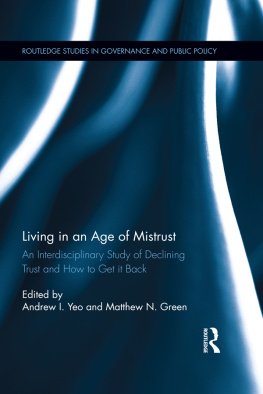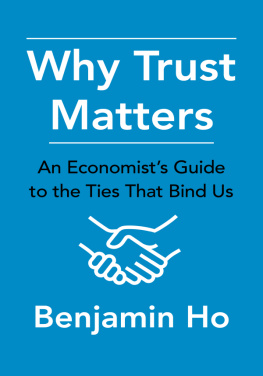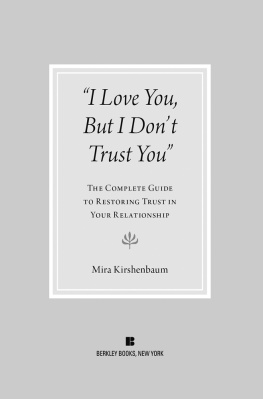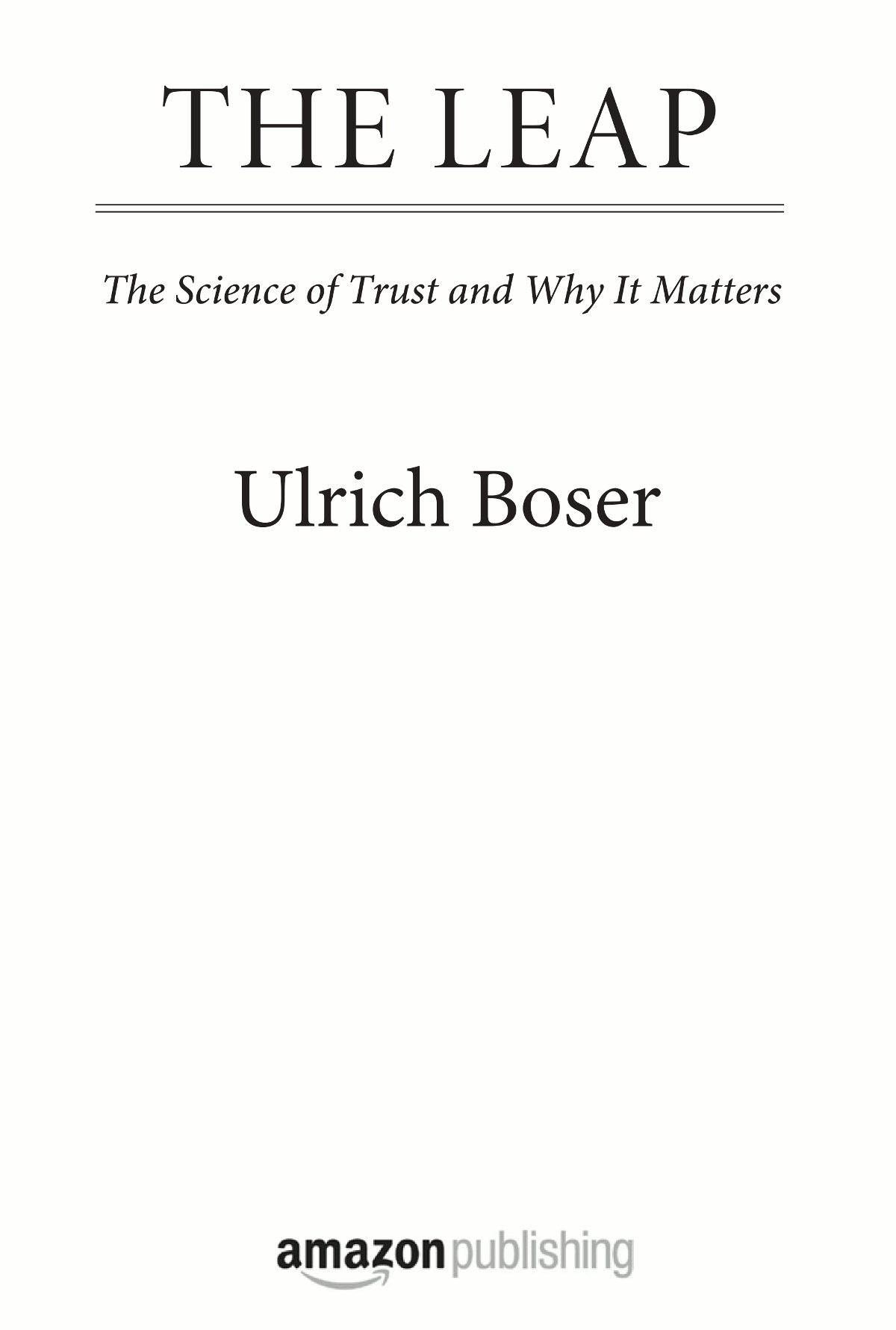
Text copyright 2014 by Ulrich Boser
All rights reserved.
No part of this work may be reproduced, or stored in a retrieval system, or transmitted in any form or by any means, electronic, mechanical, photocopying, recording, or otherwise, without written permission of the publisher.
Published by Amazon Publishing, New York
www.apub.com
Amazon, the Amazon logo and Amazon Publishing are trademarks of Amazon.com, Inc. or its affiliates.
eISBN: 9781477850299
Cover Design by Faceout Studio, Tim Green
Cover Photograph Martin Barraud
To those who have trusted me
Contents
Authors Note
Please connect with me on Facebook or Twitter or email me at .
While this is an original work of nonfiction, I have relied on many outside sources for quotes, data, and other factual information, which I have cited in the endnotes. In some instances, I have used text that first appeared in other publications. That is also indicated in the endnotes. If a quote is in italics, it means that the words may not be exact. In some instances, I may have altered quotes for grammar and clarity.
To ensure accuracy, I shared some portions of the book with experts or sources. I also hired a fact-checker to help vet the accuracy of the material. All errors of logic, fact, or writing are, no doubt, mine.
Introduction
Most of the members of the Old Christians rugby team slept in. It was the morning of October 13, 1972, and some bad weather had grounded the rugby teams charter flight to Santiago, Chile. Some of the young men had been out dancing the night before, and when they finally straggled into the airport later that day, the rugby players taunted the airplane pilots: Were the pilots too scared to cross the mountains?
The Fairchild finally rose into the sky in the early afternoon while some of the team members played card games. When a spot of turbulence shook the plane, they whooped like bullfighters.
As the small plane flew over a narrow, mountainous pass, it slipped into a dense bank of clouds. Strong winds started to rattle the aircraft. At one point, the turboprop dropped a few hundred feet, and when the clouds finally drew apart again, a rocky cliff appeared just beyond one of the wings.
Is it normal to fly so close to the mountains? one of the passengers asked.
I dont think so, his friend answered.
Moments later, there was a long shudder. A rocky crag scraped the bottom of the fuselage, and the tail section crashed away. The wings broke off. The plane soared for a moment or two before skidding down the slope of a mountain, and among the lifeless bodies and splintered
The cold was severe, something profound, and the group didnt have any warm coats. The team had packed for a trip to the ocean, not the mountains. Even worse, there was no food. The men had just a few candies and a bit of dried fruit, and within days the survivors began to feed on the frozen corpses scattered around the crash site. Sometimes the meat was cooked. Usually it was eaten raw. Then, roughly two weeks after the crash, a blanket of wet snow killed another half dozen men. It is hard to describe the depths of the despair that fell upon us in the wake of the avalanche, writes Nando Parrado in his memoir, Miracle in the Andes. Now we saw that we would never be safe in this place.
Among the men, the urge to be selfish, to take a little more food or clothing or water for themselves, was strong. Everyone was deeply hungry. Everyone was exquisitely cold. Yet the survivors figured out a way to come together, as documentaries like Stranded have suggested. They created a strict system for sleeping positions, since spots farther away from the door were warmer and more comfortable. There was no room for anyone to do anything that was against the general interest. It was like a nineteen-bodied organism.
Nearly two months after the crash, two of the survivors managed to trek out of the mountains, and the Chilean Air Force eventually saved the rest of the group. In the years since the dramatic rescue, the story of the crash has become the subject of movies, books, and documentaries, and the attraction is clear: People want to know how the group made it out alive. There are some obvious reasons for their survival. Many of the men were athletes, strong and well trained. The survivors were also young and determined. They wanted to return home, to see their families, to see their friends. Religion also played a role, and many of the survivors saw the eating of the dead bodies as something almost holy.
Perhaps most remarkable, though, is that the men built up a sense of faith in each other. Or, as Nando Parrado writes in Miracle in the Andes, None of us were saints. We survived not because we were perfect, but because the accumulated weight of our concern for each other far outweighed our natural self-interest.
Today, many of the survivors are in their sixties. Theyre doctors, lawyers, and architects. They own houses. They have grandchildren. For three decades now, the group has gotten together every December to celebrate their survival. In those moments, it seems, the men renew the community that they once created, a community built on the promise that they made to each other while they were starving in the Andes: If one of them died, the others could eat his body so that they could live.
According to popular wisdom, what happened in the Andes should not have happened. No one stuck in subzero temperatures is supposed to give up his blanket. No one stranded in a crashed airplane is supposed to share his sweater with someone else, and today, almost 60 percent of Americans argue that you cant be too careful in dealing with people. In my own research, Ive found that in some states almost no one says that they fully trust other people.
The conventional wisdom isnt fully accurate, though, and our sense of faith can be restored. We can improve our social bonds, and the reason is simple, as researcher Pamela Paxton once pointed out.
Whats more, trust turns out to be a type of social glue, and our faith in others builds social capital. It creates social networks. Its what keeps every group together, whether its a team of football players or a nation of hundreds of millions. Or think back to the men in the Andes. If they didnt have some sort of faith in each other, they could never have lived for seventy-two days in one of the worlds most desolate places.
My goal with this book is to better understand our faith in others and provide some ways to improve social trust. Or, to paraphrase Nando Parrado, I want to show how we can make our concern for each other outweigh our natural self-interest. Before we go any further, though, we have to acknowledge that society has changed, and we will not return to the social cohesion of the 1950s anytime soon. Some form of individualism is here to stay. But, at the same time, we all need to be part of something bigger than ourselves. Were all motivated by more than our own self-interest, and greater levels of social cohesion can dramatically improve the nations well-being. It can boost health outcomesand jump-start the economy. As well see, social trust can even drive down the nations murder rate.
I decided to write this book after working on an initiative to improve faith in government for the Center for American Progress, a nonpartisan think tank where Im a fellow. I became fascinated with the new research on why we trust others. I soon began visiting psychology research labs. Obscure economic studies became my bedtime reading. Neuroscientist Brooks King-Casas once scanned my brain in an fMRI to help me better understand the neuroscience of cooperation.
Next page

